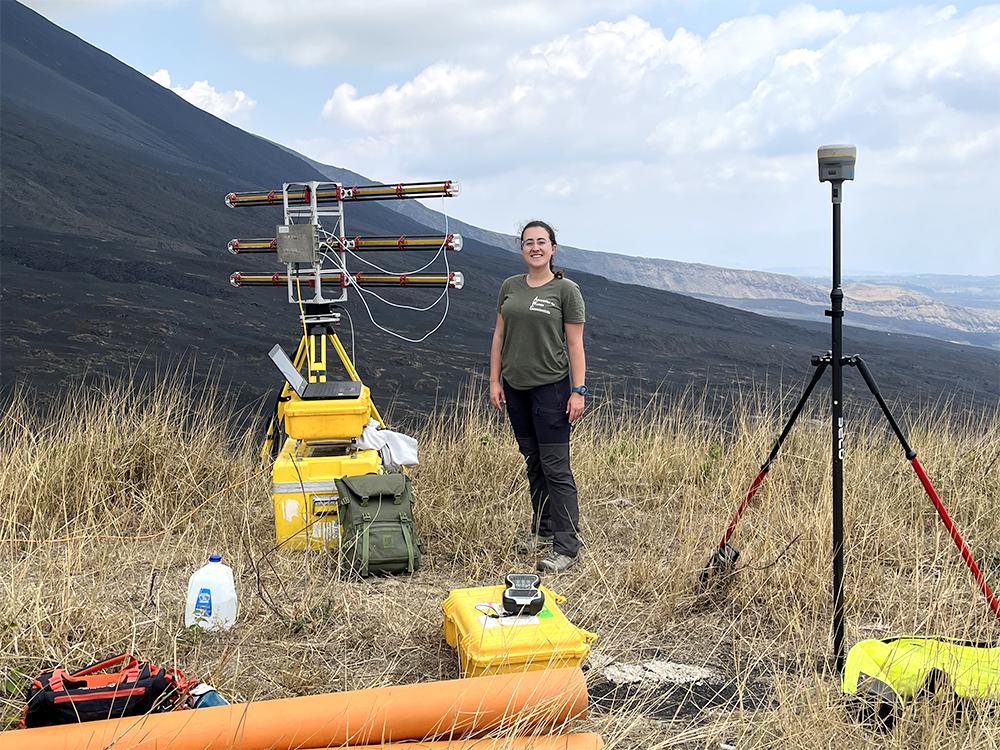OSPAs are awarded to “promote, recognize and reward undergraduate, master’s and Ph.D. students for quality research in in Earth and space science and the ability to effectively communicate it.” Judges for AGU sections assess and score student oral, poster and eLightning presentations. Typically, the top 2 to 5% of presenters who present at AGU’s fall meeting held each year in December are awarded an OSPA.
The awards are based on presentations from the fall meeting, but award winners are now in the process of being notified. Gonzalez-Santana, who gave an oral presentation, said it was really important to receive validation on her research and presentation skills.
“It was great to receive validation and very thoughtful comments from all of the judges, especially since this is as of yet unpublished work,” said Gonzalez-Santana. “I had presented previously at AGU on my first paper, which was published at the time, so I knew my findings had been peer-reviewed and that gave me a little more assurance. Whereas this research paper is in the review stages for publication in Bulletin of Volcanology, so it was very rewarding as a scientist to receive positive feedback from other scientists in my field.”
Gonzalez-Santana, who is from the Canary Islands, a volcanically active area, said she always wanted to study natural hazards that had direct applications to society.
“Volcanoes have always been really interesting to me,” said Gonzalez-Santana. “So, volcanoes and associated hazards were my main priority when choosing where to go for graduate school. Penn State does some really good research in this area, especially my adviser, Dr. Christelle Wauthier.”
Wauthier, co-author on the presentation, is an associate professor of geosciences in the College of Earth and Mineral Sciences and faculty co-hire with Penn State’s Institute for Computational and Data Sciences. Wauthier and her students study natural hazards employing remote-sensing and geophysical techniques to reveal the sub-surface dynamics of volcanic systems using models of crustal deformation.
Landslides caused by the collapse of unstable volcanoes are one of the major dangers of volcanic eruptions. Whenever there is a large volcanic eruption, there is a chance that if a flank of the volcano is unstable there could be a collapse said Gonzalez-Santana.
“Flank instability can result in catastrophic flank collapses like those that occurred at Mount Saint Helens in 1980 and more recently at Anak Krakatau in 2018; this second one was particularly damaging because it triggered an unexpected tsunami,” said Gonzalez-Santana. “My main motivation is trying to study the conditions under which these hazards might happen, and what the drivers for these hazards are so that we can improve the hazard assessment for nearby communities .”
Gonzalez-Santana’s Penn State graduate research, funded by NASA, is focused on the characterization of deformation behavior at Pacaya, an active volcano in Guatemala, using a variety of satellite acquisitions.
Michelle Burns, a fall 2021 graduate with a bachelor’s degree in geosciences, was also a co-author on the presentation.
“In my first year at Penn State I joined the Penn State Student Chapter of the Association for Women Geoscientists,” said Gonzalez-Santana. “AWG has a mentor/mentee program and Michelle was assigned as my mentee. She had experience using GIS and ended up doing her undergraduate thesis with us here in the InSAR, Geodesy, and Geohazards (IGG) lab, helping map lava flows on Pacaya spanning 2006 to 2021. It was a great experience to not only have mentored Michelle, but also to help supervise her undergraduate thesis.”
Gonzalez-Santana graduated with an integrated bachelor’s and master’s degree in earth sciences from the University of Oxford in the United Kingdom.

